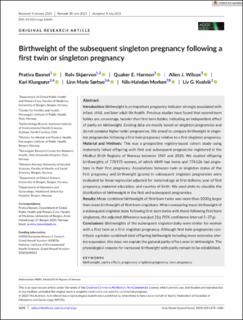| dc.contributor.author | Basnet, Prativa | |
| dc.contributor.author | Skjaerven, Rolv | |
| dc.contributor.author | Harmon, Quaker E. | |
| dc.contributor.author | Wilcox, Allen J. | |
| dc.contributor.author | Klungsøyr, Kari | |
| dc.contributor.author | Sørbye, Linn Marie | |
| dc.contributor.author | Morken, Nils-Halvdan | |
| dc.contributor.author | Kvalvik, Liv Grimstvedt | |
| dc.date.accessioned | 2024-02-13T13:44:09Z | |
| dc.date.available | 2024-02-13T13:44:09Z | |
| dc.date.created | 2023-09-07T10:47:06Z | |
| dc.date.issued | 2023 | |
| dc.identifier.issn | 0001-6349 | |
| dc.identifier.uri | https://hdl.handle.net/11250/3117343 | |
| dc.description.abstract | Introduction
Birthweight is an important pregnancy indicator strongly associated with infant, child, and later adult life health. Previous studies have found that second-born babies are, on average, heavier than first-born babies, indicating an independent effect of parity on birthweight. Existing data are mostly based on singleton pregnancies and do not consider higher order pregnancies. We aimed to compare birthweight in singleton pregnancies following a first twin pregnancy relative to a first singleton pregnancy.
Material and Methods
This was a prospective registry-based cohort study using maternally linked offspring with first and subsequent pregnancies registered in the Medical Birth Registry of Norway between 1967 and 2020. We studied offspring birthweights of 778 975 women, of which 4849 had twins and 774 126 had singletons in their first pregnancy. Associations between twin or singleton status of the first pregnancy and birthweight (grams) in subsequent singleton pregnancies were evaluated by linear regression adjusted for maternal age at first delivery, year of first pregnancy, maternal education, and country of birth. We used plots to visualize the distribution of birthweight in the first and subsequent pregnancies.
Results
Mean combined birthweight of first-born twins was more than 1000 g larger than mean birthweight of first-born singletons. When comparing mean birthweight of a subsequent singleton baby following first-born twins with those following first-born singletons, the adjusted difference was just 21 g (95% confidence interval 5–37 g).
Conclusions
Birthweights of the subsequent singleton baby were similar for women with a first twin or a first singleton pregnancy. Although first twin pregnancies contribute a greater combined total offspring birthweight including more extensive uterine expansion, this does not explain the general parity effect seen in birthweight. The physiological reasons for increased birthweight with parity remain to be established. | en_US |
| dc.language.iso | eng | en_US |
| dc.publisher | Wiley | en_US |
| dc.rights | Navngivelse-Ikkekommersiell 4.0 Internasjonal | * |
| dc.rights.uri | http://creativecommons.org/licenses/by-nc/4.0/deed.no | * |
| dc.title | Birthweight of the subsequent singleton pregnancy following a first twin or singleton pregnancy | en_US |
| dc.type | Journal article | en_US |
| dc.type | Peer reviewed | en_US |
| dc.description.version | publishedVersion | en_US |
| dc.rights.holder | Copyright 2023 The Author(s) | en_US |
| cristin.ispublished | true | |
| cristin.fulltext | original | |
| cristin.qualitycode | 1 | |
| dc.identifier.doi | 10.1111/aogs.14644 | |
| dc.identifier.cristin | 2173144 | |
| dc.source.journal | Acta Obstetricia et Gynecologica Scandinavica | en_US |
| dc.source.pagenumber | 1674-1681 | en_US |
| dc.identifier.citation | Acta Obstetricia et Gynecologica Scandinavica. 2023, 102 (12), 1674-1681. | en_US |
| dc.source.volume | 102 | en_US |
| dc.source.issue | 12 | en_US |

